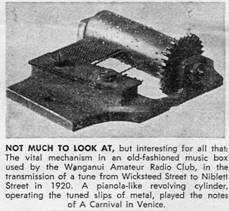Wanganui Branch History
INDEX < Prev 1 2 3 4 5 6 7 8 Next > ..... 40
Pioneering Days of Wanganui Radio
Life Member of the Wanganui Amateur Radio Club (Mkl) Mr Ray Withers became interested in radio away back in 1914 when, at the age of 16, he was a clerk in his law firm. He could well remember the year because of the outbreak of World War 1 on 4th Auugust and anybody having anything to do with a radio transmitting set was 'under suspicion.'
"An engineer from the Post and Telegraph asked me whether it was true that I was messing about with radio" and on confirming this I was told to be careful and not use the set said Mr Withers. A certain amount of time went by and then I was awakened out of bed early one morning by a man from the Department who took me down to the shed to dismantle the set. "It was too silly for words, really, because we couldn't communicate far, if at all!" said Mr Withers.
In 1919, the year after the war ended, radio enthusiasts got busy again, with Mr Withers the prime mover, resulting in the (first) Wannganui Amateur Radio Club being formed in 1920, at a time when practical radio work by amateurs was entirely forbidden. (It is claimed that this was the first Amateur Radio Club in ZL!) Nevertheless, the first members, numbering about a dozen, were keen enough on the science to devote spare time to theoretical study. At that time valves were a dimly understood thing, and not one of the members had even seen one. Others involved with Roy Withers included Stan Freeman, Rowe Robinson and Gordon Bissett. Gordon Bissett had a room in the Rutland Hotel in the region above the taxi stand. This was the Club's first 'club room' before the shift to the YMCA.
As soon as the restrictions on amateur working were lifted, the members commenced building apparatus, and fearful and wonderful were the contraptions put together! The first signals from VLW were hailed with delight, and the enthusiasm of the members was greatly stimulated. Soon after this a valve was obtained by the Club, and incorporated in what we now know as the De Forest Ultra-Audion circuit. With this, signals from VLA, VLB, VLD, and VLC were received on an inside aerial erected in the club-room which, incidentally, was a vacant room forming part of the Secretary's office. Gradually the knowledge of the members grew, as did also the number of stations logged by the various receiving sets. 
Of course, in those days, no telephony was dreamed of, and the average amateur spent most of his time juggling with intricate circuits rather than in listening to Morse, which he probably could not read at all.
The first telephony was received on 600 metres, from a station which could not be identified since no call was given. It was presumed, however, that the station was Melbourne since no station in New Zealand was known to be transmitting. Some time after this Mr. C Forrest commenced working in Wellington, with a De Forest O.T.3 set, and one or two members of the Wanganui Club were successful in receiving him almost right away. The phones had to be screwed into one's ears and absolute silence observed before the music could be heard, but it was there all right!
By about 1921 the band of radio enthusiasts developed transmitting and receiving sets to such a standard that Morse was replaced by the speaking voice. Two of the enthusiasts were Messrs L M Mellars, who was the Treasurer of the Wanganui Amateur Radio Club, and J Whelan, a cinematograph operator of the now defunct Grand Theatre.







